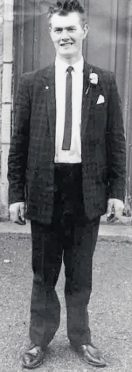George Smith, 81, was brought up in Aberdeenshire and has worked on various farms in the area. This is part one of a letter which he wrote, about the ups and downs of his younger days.
I was born on a farm in 1935, the fourth child in a family of eight children. The farm was the Mains of Toquhon, which was near the village of Tarves, in Aberdeenshire. After being there for a while, we moved to another farm, not too far away, called Cairnbrogie.
By the time I was ready for school we had moved again to Strocherie, near the village of Plaidy, on the road from Turriff to Banff. We lived in an old croft house.
At that time I had two older brothers and a sister. I started school and we had a good three miles to walk to Fintry School. I remember one thing – the dinners were good. They were made by two local women. The best day was a Friday, as we got a mug of cocoa and a couple of hot bridies.
It was very bad weather that year and the roads were blocked for weeks on end. There was no high powered machinery like they have today. Some parts of the road were so deep they had to clear it with shovels. Men would cut the snow into square blocks and throw them up onto the sides of the road. But as soon as they were cleared they would fill up again.
Most Sundays my father, two brothers and I would go to a nearby wood to cut some firewood. Then we would take them home on a horse and cart. The next couple of hours would be spent sawing them into logs with a big crosscut saw – enough to last the week.
When it was time for my eldest brother to leave school he was lucky enough to get a job on a small farm nearby. As young as I was, I had to take my turn doing jobs around the house.
The water had to be pumped, using an old pump beside the house. During the winter, it always had to be covered to keep out the frost. It always had to be primed, so we kept a pail of water handy. The toilet was in a wooden hut, at the bottom of the garden, with a bench and a hole for the bucket.
There was an old quarry nearby where the tinkers used to camp. They worked on the farms that grew flax. In those days most of the farmers used horses, except for a few of the farms which had a tractor – usually a Fordson. Some of them would have iron wheels, or spade lugs as they were called.
They were handy for the wet fields. The tractors back then had two fuel tanks, one for petrol and the other for paraffin. You would first start in with petrol, and when the engine got warm, you would switch it over to paraffin. Paraffin was cheaper to run anyway.
The tractors all had a big starting handle at the front. One had to be very careful when turning it that you didn’t have your thumb over the top because it could recoil and break your thumb.
Nearby all the farms had a bothy for the single men, or a chalmer, as they were called in Aberdeenshire. They were always above or near to the stable for easy access to the horses. Most of the men were fed in the farm house, but in Angus the single men made their own food in the bothy. But then they were a bit better paid than in Aberdeenshire.
Farms in the early days would employ men for a term of six months. At the end of the term, if you weren’t asked back by the grieve or the farmer you knew to look for another job.
The grieve took his orders from the farmer but was in charge of the rest of the men and gave them their orders. He would also expect to be shown some respect.
For example, if he lived in the bothy he would be given the side of the bed nearest the fire, sit at the top of the table at meal times and be allowed to wash first in the basin.
A bad-tempered grieve could make life very hard for the men.
The men would usually flit on a Saturday afternoon, and in the early days it was done by a horse and cart. I remember my father telling me that the horse and carts would sometimes pass each other, one going into the farm and the other coming out.
When I was a young lad the flittens were done either by using a flat lorry or a cattle truck. If it was a flat lorry then everything had to be well tied with the ropes.
My mother and sister would sit in the front beside the driver and my father, my two brothers and myself would all sit on the back. We got a good view of the countryside, so it was nice – as long as it didn’t rain. If we moved with the cattle float, one would always smell of the cattle market from the day before. No matter how often it was washed out.
To be continued . . .
Why not share your memories with the YL readers? Contact Natasha on 01224 343382, send her a message at natasha.mckim@ajl.co.uk or write to YL magazine, Lang Stracht, Aberdeen, AB15 6DF
